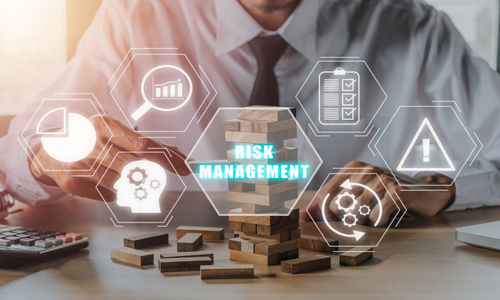COVID-19 has been a stark answer to the level of risk management different enterprises possess. Only the businesses with above-par strategies survived the tide and continued to sail. Here is an insight into the need for adopting as well as upgrading risk management strategies with time. This is 2023, and it is time to renew the conventional practices of facing hazards alongside exploring risk areas.
Jump ahead to
Advantages of having Risk Management Strategies
Every business is more or less subject to operational and project risks. Only an effective risk management plan can make an enterprise identify both its opportunities and vulnerabilities. An enterprise reaps the following benefits from risk management planning.
Business continuity
Operational risks can occur without prior warning to an enterprise. For instance, it may stop receiving service from its existing providers or suffer equipment failure all of a sudden. There is also the possibility of an advanced cyber attack that the organization isn’t aware of. This calls for the implementation of robust internal controls to ensure business continuity. These controls are none other than risk management strategies.
Asset protection
Safeguarding an organization’s assets in the form of confidential data or tangible resources is of prime concern. Risk management strategies minimize the impact of security breaches. As a result, the company suffers much less loss than what is expected from a sudden attack.
Customer satisfaction
Organizations possessing well-etched risk management plans attract a relatively large number of consumers. The latter feels confident about the integrity and reputation of such enterprises. Thus, risk management strategies help brands maintain their market presence and loyalty to their customers. Consumers can rely on the delivery of services or products offered by such brands to meet their expectations.
Achieve goals
Formulating appropriate risk management strategies is vital for enhanced business performance. It helps an enterprise to obtain its desired project portfolio. Risk assessment and identification activities lead to faster exposure of potential dangers to a business. Every attack is just an obstruction to the timely completion of each project that an organization deals with. Therefore, it is better to get rid of such attacks as soonest possible.
Enhanced profitability
Any type of security breach directly affects an organization’s financial security to an extent depending on the attack’s severity. An enterprise has to disrupt its normal workflow to conduct lengthy investigations with its insurance and legal teams. Risk management strategies are meant to control credit-related threats to a business.

What are Risk Management Strategies?
It is a cyclical approach to handling risks continually. Organizations can walk on the path of securing their assets and people through the steps involved in risk management planning. These steps are namely, risk identification, assessment, management, and monitoring. Organizations of every size and industry can apply the same.
Risk identification – Implementing control processes and tools is the foremost step in actively tracing potential risks. Being proactive is the key to minimizing the risk probabilities.
Risk assessment – The number of risk assessment tasks varies from one business to another, depending on the complexity and size. An essential aspect of risk management strategy is prioritizing the vulnerabilities after identifying them. Reviewing systematic documentation of such risk analyses is crucial. This allows an organization to be aware of the more severe attacks and stay prepared to counteract them.
Risk response – Organizations must develop and enforce risk-controlling measures for handling security threats at the right time. This would curb the major impact of the mishap even if it occurs by chance.
Risk monitoring – It refers to the continuous supervision of the risk management procedure. This helps track the severity of an attack that prompts an organization to take the necessary action.
Different Risk Management Strategies Of 2023
Here is a glance through the risk management strategies that are equally effective and ideal for organizations.
Business experiments
Creating scenarios to find out their outcomes along with possible potential threats is an excellent strategy. Only through experimentation can one identify the results of a particular circumstance and include or avoid it. Such business experiments facilitate the assessment of different financial metrics and even ROI.
User feedback
The feedback from a product’s end users helps detect design flaws and to overcome potential challenges. Organizations must conduct surveys and prepare questionnaires to gather information from their consumers. It is crucial to the timely management of risks.
Software development
One of the prominent risk management strategies is to develop software with features useful for consumer assistance. This prevents a project from exceeding its scope and reduces its financial burden. Thus, companies can quickly launch their product in the market and access it faster.
Risk isolation
Faulty procedures often leave room for vulnerabilities of different kinds in a business. An effective risk management technique is to isolate such processes from others. This activity will make an enterprise proactive in finding security threats before they are likely to occur.
Build buffers
Building buffers is essential to ensure a project’s activities stay within scope. Buffers related to project completion time, resources, or finance prove helpful in determining a project’s defects. Doing away with such defects lets an enterprise avoid all possible risks in its execution.
Data analysis
A qualitative risk assessment is crucial in determining the impact of different security breaches and prioritizing them accordingly. Organizations conducting such analyses are at an advantage over their counterparts. Developing, monitoring, and re-evaluating data assessment results is a never-ending cycle to stay aloof from business risks.
Risk-reward comparison
Studying the comparison between the benefits and risks of a project or task is an excellent risk management practice. This allows an organization to decide on the fruitful investment of time, money, and resources.
Lessons learned
Project teams must consider the outcomes of every successful or incomplete task as lessons to use as future references. Documenting those lessons is of substantial importance among the varying risk management strategies. It helps to discuss the weaknesses and strengths of the previous process to evaluate the following risks.
Alternate planning
Another vital risk management policy is not to rely on a single risk mitigation plan but to keep alternatives ready. Even if one plan fails, the next one will work wholly or partly to save the project and keep it sailing.
Risk management strategies discussed here are powerful enough for companies to resist external and internal attacks. Businesses can now become more competent to survive the industry competition, especially in this post-pandemic era. PMI RMP Training programs are beneficial for those desiring to take part in developing risk management strategies.



